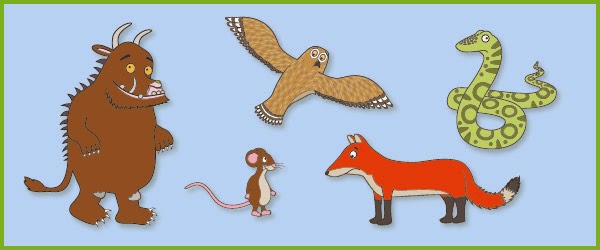Title: The Animal Boogie
Fred Penner (Author)
Debbie Harter (Illustrator)
Summary:
Can you boogie? Down in the Indian jungle, the children and animals are learning about actions like leaping, stomping, shaking and flapping while meeting jungle creatures. (Summary from Barefoot Books.)
Materials: The Animal Boogie
optional toy binoculars OR toilet-paper tube binoculars
Lesson:
We're going down in the jungle.
Come if you dare.
Come if you dare.
Turn your story time into a moving singing adventure with The Animal Boogie—an award winning title from Barefoot Books. The simple, predictable text, written as a song by acclaimed children's performer Fred Penner, offers clues to the discovery of six different animals, each with their own movements and own style of "boogie boogie." The inviting illustrations by Debbie Harter are arranged in a pattern so that every other page first invites students to look for details and then surprises them with with a child and animal dancing pair. My favorite reason for recommending this book for story time is the accompanying song, performed by Fred Penner himself. (The book includes an enhanced CD with the song on it, plus an animated video.)
Want to see if this sing-along book is right for your literary jungle? Take a peek at the video:
Prior to your story time, purchase toy binoculars from a discount store or make pretend binoculars by stapling pairs of toilet paper rolls together. Provide the children with the binoculars. Explain that there are many things they will see "down in the jungle" and that it will be important to focus on important details in the illustrations. As you read the verses of the book, the questions in the text will provide clues as to what the children should look for. For example:
"What can you see swinging through the trees?"
"What can you see stomping its feet?"
"What can you see flying in the sky?"
Ask the children what special body parts each animal has to help it boogie oogie. Then help the children discover ways that they can move their own bodies like each animal. Use the binoculars again to examine how the illustrated children are copying the dancing animals. At this point, taking a break to dance along with the CD is sure to be a hit!
To extend the movement opportunities, also consider these ideas:
Dance a pattern.
Have the children help you decide on a movement that will be repeated every time you hear "boogie, woogie, oogie!" For example, in the following verse featuring the bird, students might flap their arms and then point upward. In this way, the movements become a slightly choreographed dance with an AB pattern.
"IT'S A BIRD!
He goes flap, flap, boogie, woogie, oogie.
Flap, flap, boogie, woogie, oogie!
Flap, flap, boogie, woogie, oogie!
That's the way he's flying in the sky!"
Dance with a partner.
Invite pairs of children to face each other as they dance the pattern described above. You might also challenge them to take turns so that one partner does the first movement and the second child does the movement designated for "boogie, woogie, oogie." Students are introduced in a simple way to the teamwork of partner dancing.
Dance in an ensemble.
Assign each of six children a different animal part. Then have the entire group of children form a circle. As his or her animal is featured, each of the six children can be invited to step into the middle of the group to perform the animal's action. The group continues to move along in the "boogie, woogie, oogie" style. All dancers sway on the last verse. What a performance!


















































